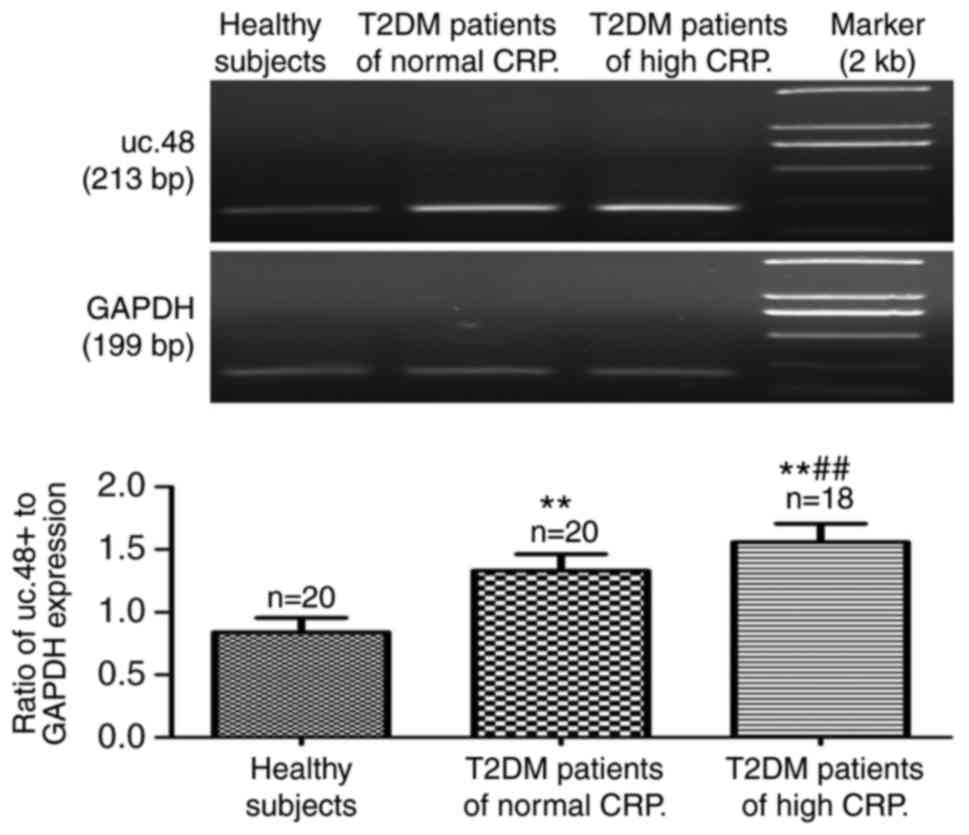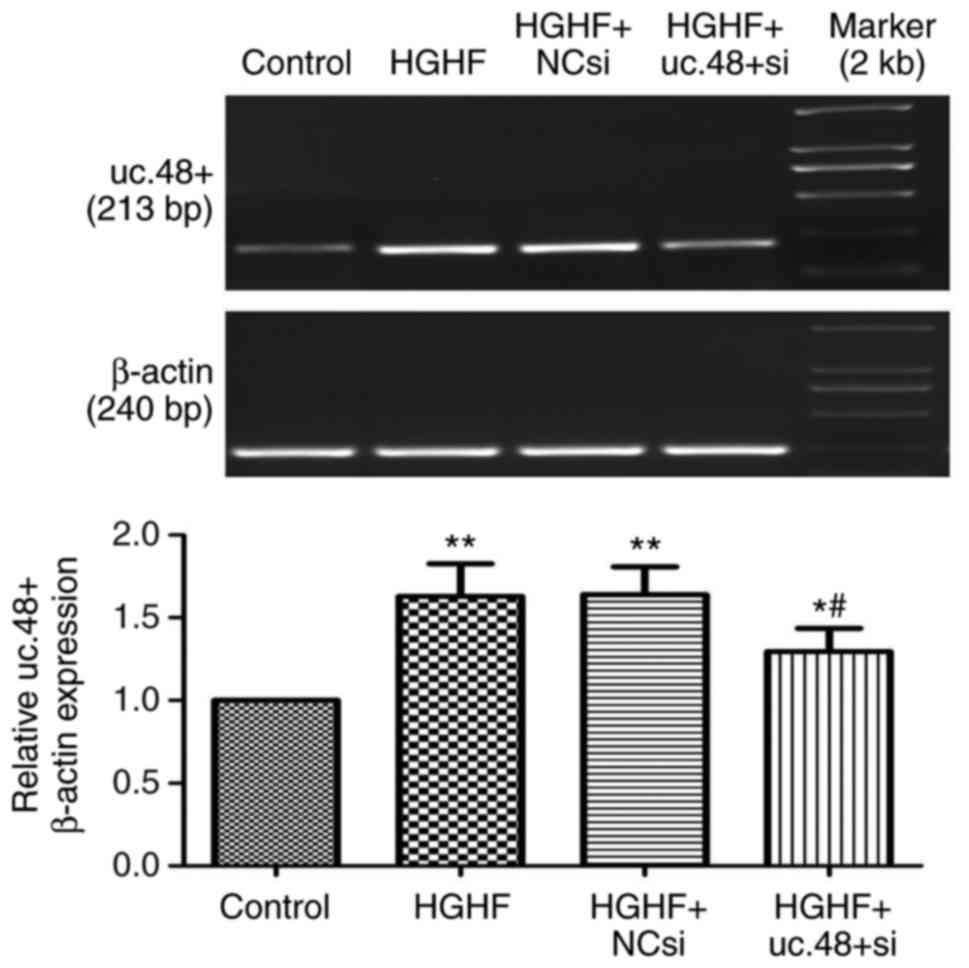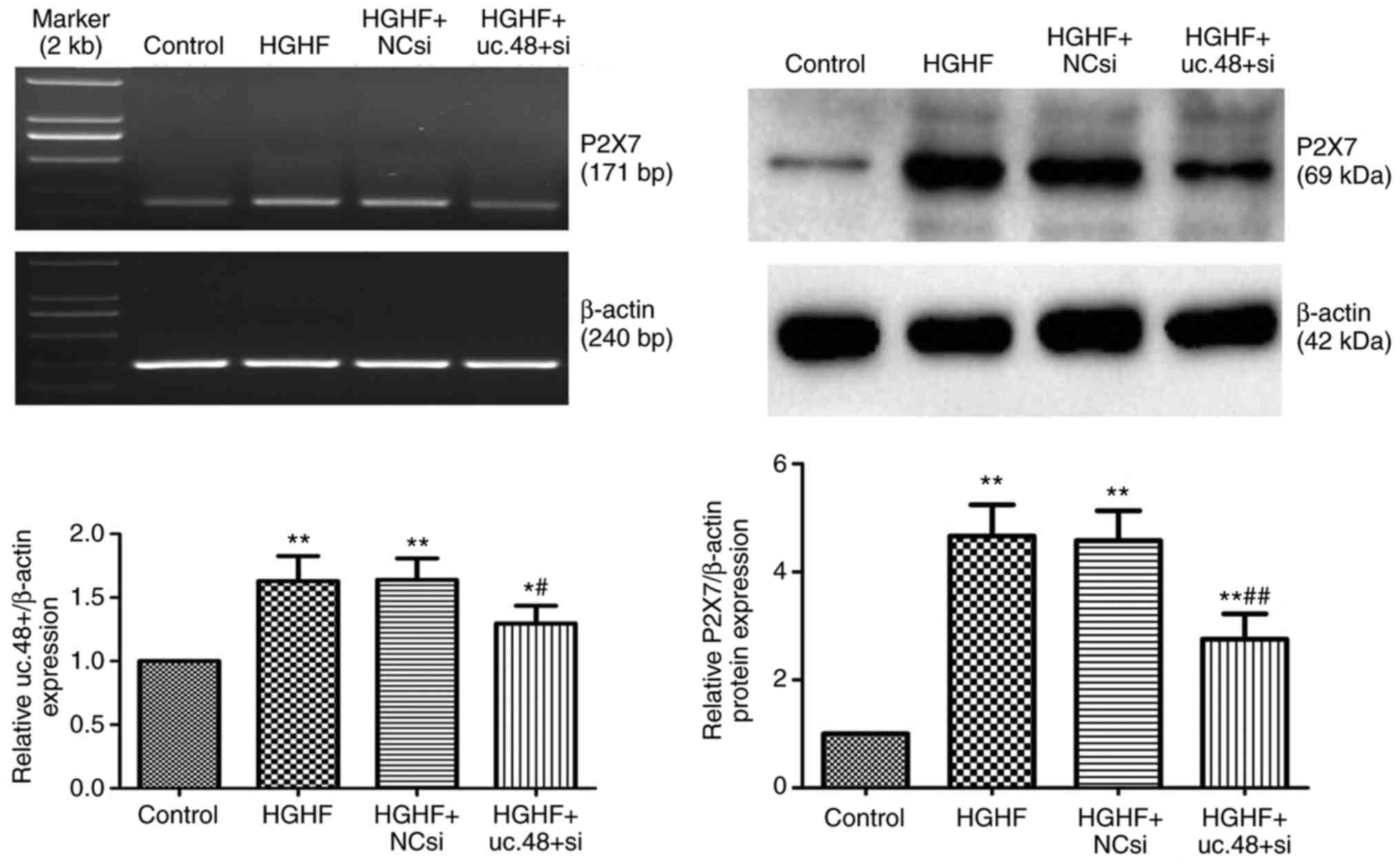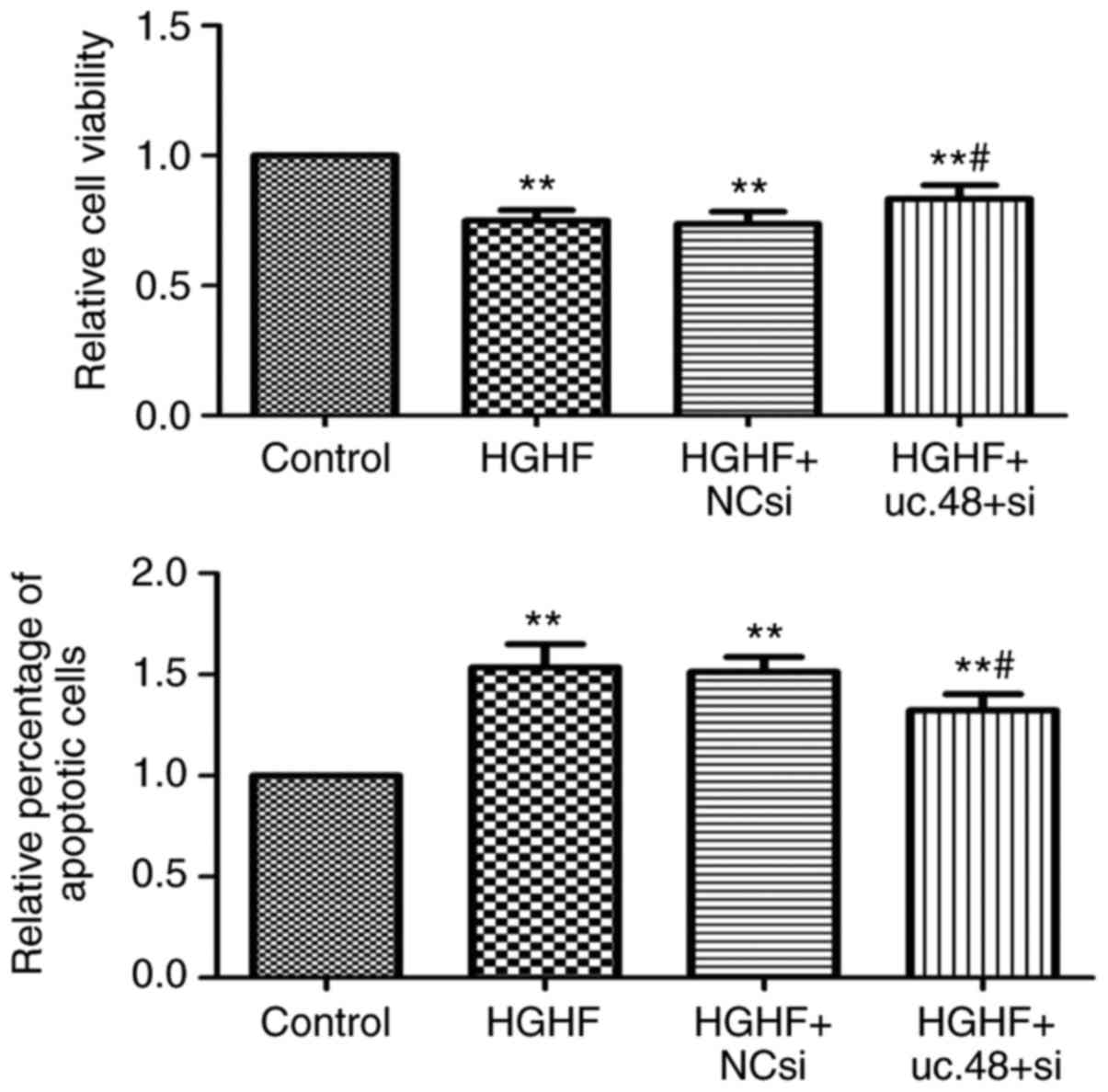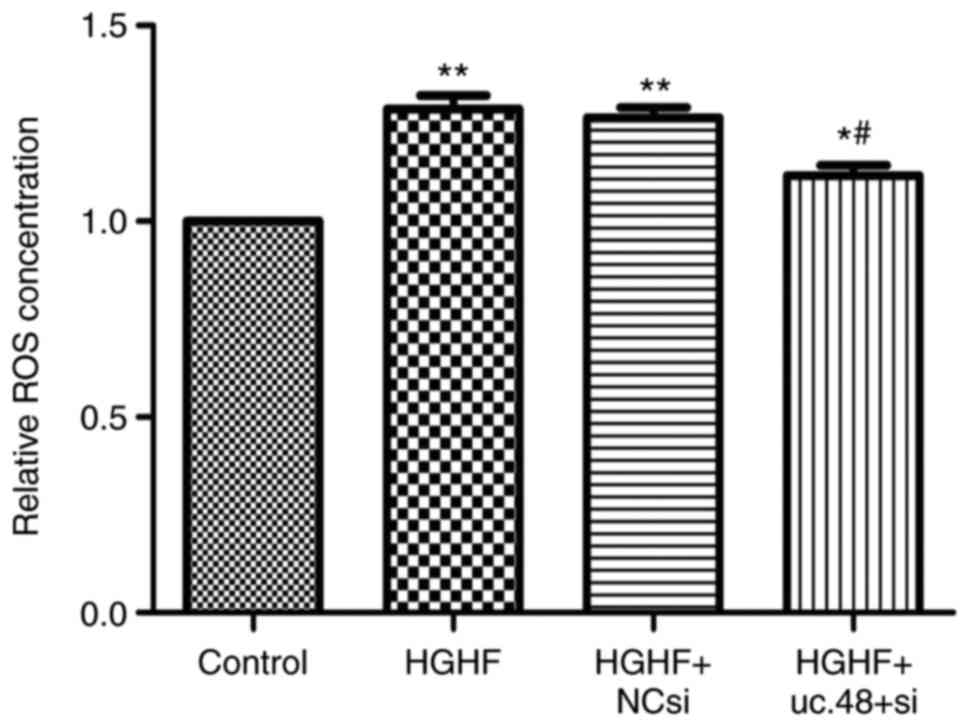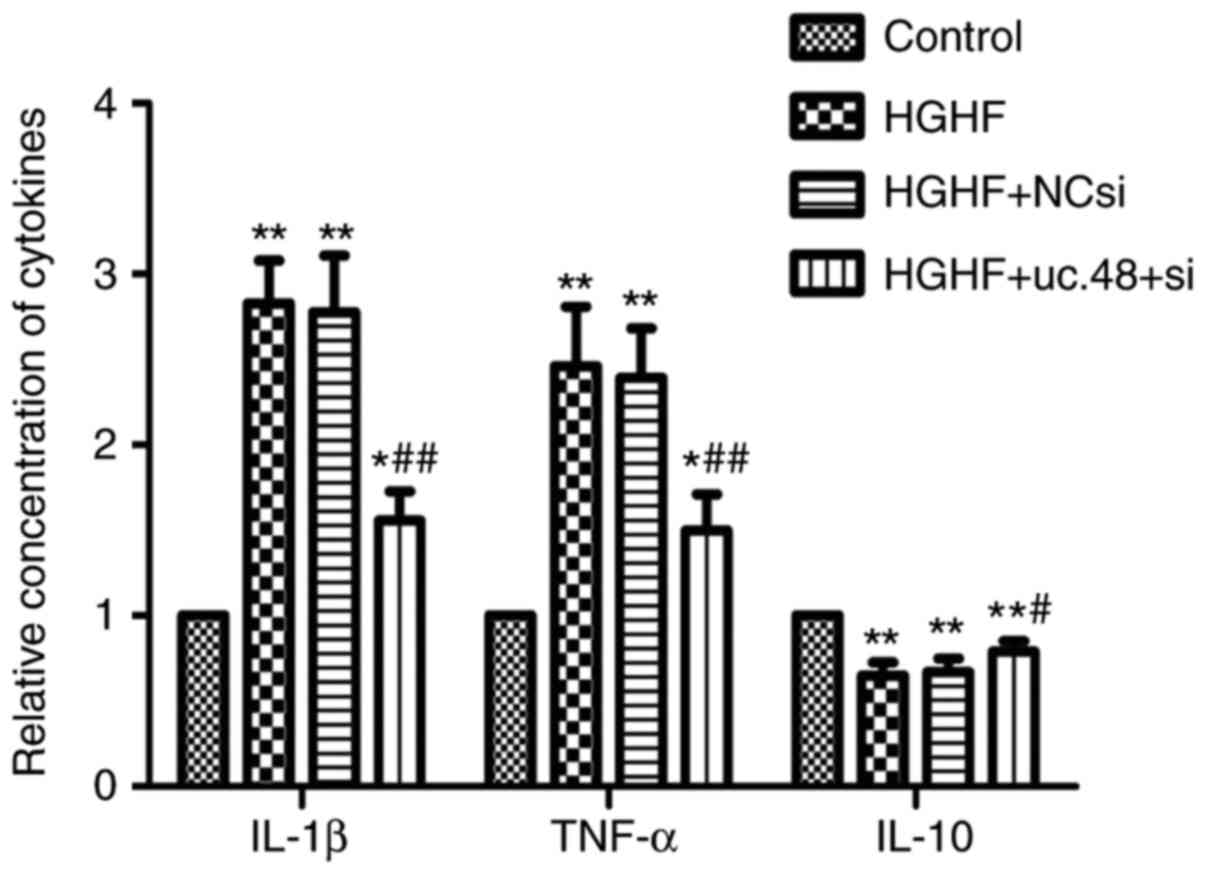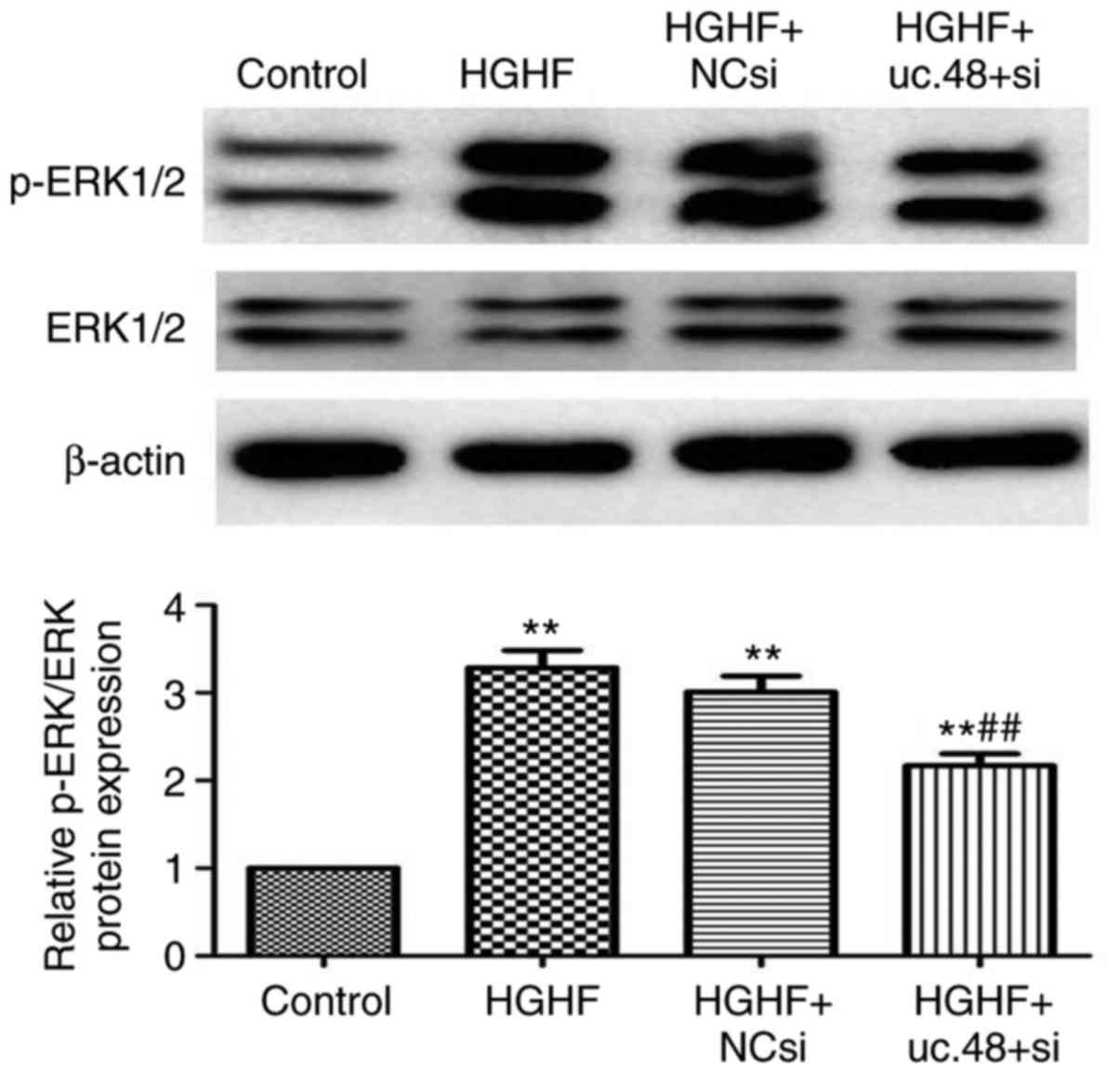LncRNA uc.48+ is involved in the diabetic immune and inflammatory responses mediated by P2X7 receptor in RAW264.7 macrophages
- Authors:
- Published online on: May 9, 2018 https://doi.org/10.3892/ijmm.2018.3661
- Pages: 1152-1160
Abstract
Introduction
The majority of patients with type 2 diabetes mellitus (T2DM) have the characteristics of high blood lipids in addition to high glucose (1,2). High plasma free fatty acids (FFAs) are associated with insulin resistance, inflammation and oxidative stress, which are a result of advanced diabetes mellitus (3). Therefore, high glucose combined with high FFAs can contribute to the unfavorable development of T2DM. By contrast, monocytes/macrophages are important in the occurrence and development of T2DM, which is regarded as a type of low-grade inflammation (4,5). In our previous study, it was demonstrated that the increased expression of P2X7 receptor (P2X7R) in peripheral blood monocytes may alter the innate immune system, contributing to the development of T2DM (6). The high plasma FFA levels in the inflammatory condition of T2DM may result in the continuous secretion of intracellular ATP, which causes the accumulation of extracellular ATP (7). Overstimulation of the P2X7R by increasing levels of extracellular ATP may induce uncontrolled Ca2+ influx and activate the release of mature cytokines, including interleukin (IL)-1β, IL-18 and tumor necrosis factor (TNF)-α (8,9).
Transcriptome analysis has revealed that only 1-2% of the human gene encodes protein and the remaining 98% of the human gene is non-coding RNA (10,11). Long non-coding RNAs (lncRNAs) represent a subgroup of non-coding RNAs, which are >200 nucleotides in length and lack the ability to encode proteins (10). Studies have shown that lncRNAs regulate various biological processes, including the expression of genesin epigenetics at the transcription and post-transcription levels (12) and they are involved in the regulation of apoptosis, proliferation and differentiation (13). In previous years, studies have identified several hundred lncRNAs characterized with absolute conservation (100% homology with no insertions or deletions) in the human, mouse and rat genomes (14,15). These conserved lncRNAs have been named ultra conserved RNA (ucRNA). The uc.48+ is one identified lncRNA (http://genome.ucsc.edu). Although our previous preliminary results revealed that lncRNA uc.48+ was involved in diabetic neuropathic pain (16), the role of uc.48+ in monocyte/macrophages has not been reported. Therefore, the present study focused on the role of uc.48+ and its possible mechanism in high glucose and FFA-induced immune and inflammatory responses mediated by P2X7R in RAW264.7 macrophages.
Materials and methods
Individuals and serum RNA isolation
A total of 20 healthy subjects were enrolled from the Blood Center of Jiangxi Province (Nanchang, China). In addition, 38 patients fulfilling the American Diabetes Association diagnostic criteria for T2DM, including 20 patients with normal C-reactive protein (CRP) and 18 patients with high CRP, were recruited from the First Affiliated Hospital of Nanchang University (Nanchang, China). The present study was approved by the local Ethics Committee of from the First Affiliated Hospital of Nanchang University (approval no. 2018 16), and written informed consent was obtained from each individual.
The participant recruitment/samples were collected between June 1, 2014 and August 31, 2014. Blood samples obtained from all individuals were collected and allowed to coagulate for 30 min at room temperature, followed by centrifugation for 10 min at 1,300 × g at 4°C. The collected sera were centrifuged for another 10 min at 3,000 × g at 4°C to remove any remaining cellular components, divided into 500-µl aliquots, and stored immediately at −80°C.
Cell culture exposure to high glucose and FFAs
The RAW 264.7 murine macrophage-like cell line was purchased from the Type Culture Collection of the Chinese Academy of Sciences (Shanghai, China). The cells were cultured in DMEM medium (low glucose; Gibco; Thermo Fisher Scientific, Inc., Waltham, MA, USA; cat. no. 11885092) containing 10% fetal bovine serum (FBS; Hyclone; GE Healthcare Life Sciences, Logan, UT, USA), 100 U/ml penicillin, and 100 mg/ml streptomycin sulphate at 37°C in a humidified atmosphere containing 5% CO2. Based on a previous report, the treatment doses of high glucose (17) and high FFAs (18) were 44.4 and 1.0 mM, respectively, throughout the study.
uc.48+ siRNA treatment
The siRNA specific for uc.48+ was purchased from Invitrogen; Thermo Fisher Scientific, Inc., with the target sequence of 5′-GGC ACT ACT ACT TGC AGA A-3′. The siRNA oligonucleotides that specifically targeted uc.48+ were used in this experiment (16). The uc.48+ was knocked down by RNA interference using Entranster™ RNA transfection reagent. According to the manufacturer's protocol of the transfection reagent (Engreen Biosystem Co., Ltd. Beijing, China), the uc.48+ siRNA injection at a final concentration of 20 mM was used for subsequent experiments.
Cell treatment and experimental groups
The RAW264.7 macrophages were treated under control [5.5 mM glucose +1% bovine serum albumin (BSA; Zhejiang Tianhang Biotechnology Co., Ltd. Hangzhou, China], high glucose and high FFA (44.4 and 1.0 mM, respectively) conditions for 3 days. RNA was isolated following treatment in the presence of uc.48+ siRNA or scramble siRNA for 48 h. The other experiment assays (western blot, cell viability and apoptosis assays, and measurement of ROS) were performed following treatment in the presence of uc.48+ siRNA or scramble siRNA for 72 h. The supernatants were stored at −80°C for the enzyme-linked immunosorbent assay. For experiments, the four following groups were assigned: Control group, high glucose and FFA treatment (HGHF) group, uc.48+ siRNA vector-treated HGHF group (HGHF+ uc.48+ si), and scramble siRNA vector-treated HGHF group (HGHF+ NC si).
Serum RNA and total RNA isolation, and reverse transcription-polymerase chain reaction (RT-PCR) analysis
Serum RNA was isolated from the serum using RNA pure Circulating Reagent (CWBIO, Beijing, China; cat. no. CW2281), with modifications. Briefly, 300 µl of serum was added to three volumes of RNA pure Circulating Reagent, mixed thoroughly by vortexing and left to stand at room temperature for 5 min. Subsequently, one-fifth of the volume of chloroform was added and shaken vigorously for 30 sec, incubated for 5 min at room temperature, and then centrifuged for 20 min at 12,000 × g at 4°C. The upper aqueous phase was transferred into a new collection tube and one volume of isopropanol was added, mixed thoroughly for 30 min at room temperature, and centrifuged for 20 min at 12,000 × g at 4°C. The precipitate was washed twice with 1 ml of 75% ethanol (diluted with DEPC water). The RNA was eluted by 20 µl of RNase-free water. The RAW264.7 macrophages were treated with the control, high glucose and high FFA conditions in the presence of uc.48+ siRNA or scramble siRNA for 48 h. Total RNA was isolated using TRIzol (Invitrogen; Thermo Fisher Scientific, Inc.), according to the manufacturer's protocol. The quality of the RNA was profiled using NanoDrop 2000 spectrophotometer (Thermo Fisher Scientific, Inc.).
RNA was used to synthesize cDNA in 20 µl reactions containing 500 ng of DNase-treated RNA, 200 ng of random hexamers, 100 U of Revert Aid reverse transcriptase and 8 units of RiboLock RNase Inhibitor using a Revert Aid First Strand cDNA Synthesis kit (Fermentas; Thermo Fisher Scientific, Inc.). The reaction samples were incubated for 10 min at 25°C and 60 min at 42°C, followed by enzyme inactivation for 10 min at 70°C and storage at −20°C until use. In the serum experiments, PCR amplification of the uc.48+ and GAPDH (internal standard for quantification) was performed according to our previously described method (19). A total of 2 µl cDNA was amplified in 12.5 µl of PCR mixture (Tiangen Biotech Co., Ltd. Beijing, China), 2 µl primers (1 µl sense primer and 1 µl antisense primer) and 8.5 µl nuclease-free water. The oligonucleotides used to amplify the uc.48+ and GAPDH were as follows: uc.48+, sense 5′-GCA AAC TGG ATG AGG AT-3′ and antisense 5′-GTA GTG CCA CAA GGA GA-3′, and GAPDH, sense 5′-CAG GGC TGC TTT TAA CTC TGG T-3′ and antisense 5′-GAT TTTGGA GGG ATC TCG CT-3′. The length of the PCR product was 231 bp for uc.48+ and 199 bp for GAPDH. The PCR conditions of uc.48+ and GAPDH included a hot start at 94°C for 3 min, 45 sec denaturation (94°C), 45 sec annealing (57°C), and 45 sec extension (72°C) for 36 (uc.48+) or 32 (GAPDH) amplification cycles, and a final 5-min extension at 72°C.
In the RAW264.7 cell experiment, the PCR amplification of the P2X7R and β-actin (internal standard for quantification) was performed according to our previous method using oligonucleotides as described previously (16). A total of 2 µl cDNA was amplified in 12.5 µl PCR mixture (Tiangen Biotech Co., Ltd.), 2 µl primers (1 µl sense primer and 1 µl antisense primer) and 8.5 µl nuclease-free water. The following primers were used for PCR analysis: P2X7R (171 bp), sense 5′-GCA CGA ATT ATG GCA CCG TC-3′ and antisense 5′-CCC CAC CCT CTG TGA CAT TC-3′; uc.48+ (231 bp), sense 5′-GCA AAC TGG ATG AGG AT-3′ and antisense 5′-GTA GTG CCA CAA GGA GA-3′; β-actin, (240 bp), sense 5′-TAA AGA CCT CTA TGC CAA CAC AGT-3′ and antisense 5′-CAC GAT GGA GGG GCC GGA CTC ATC-3′. The PCR conditions of uc.48+, P2X7R and β-actin included a hot start at 94°C for 3 min, 45 sec denaturation (94°C), 45 sec annealing (57°C for uc.48+ and β-actin; 59°C for P2X7R), and 45 sec extension (72°C) for 36 (uc.48+ and P2X7R) or 32 amplification cycles (β-actin) and a 5-min final extension at 72°C.
The PCR products were run on 1.5% agarose gels with EB using standard protocols. Densitometric analysis of three different observations was performed using Image-Pro Plus software (version 6.0, Media Cybernetics, Inc., Rockville, MD, USA). In the experiments involving patient serum samples, the results are expressed as the ratio of the uc.48+ band intensity/GAPDH band intensity. In the RAW264.7 cell experiments, the results are showed as the ratio of uc.48+ or P2X7R band intensity to β-actin band intensity.
Western blot analysis
The cells were washed twice with ice-cold PBS and harvested. The lysates were obtained using RIPA buffer containing a protease/phosphatase inhibitor mixture (diluted 1:100, Vazyme Biotech, Nanjing China) and then subjected to 10,000 × g centrifugation at 4°C for 20 min. Total protein concentrations in the supernatant were determined using a bicinchoninic acid assay (Beyotime Institute of Biotechnology, Haimen, China). A total of 30 µg protein was separated by 6% sodium deodecylsulfate-polyacrylamide gel electrophoresis, which was then transferred onto polyvinyl difluoride membranes (Millipore, Bedford, MA, USA) by electroblotting. Following blocking with 5% BSA at room temperature for 2 h, the blots were incubated with the following primary antibodies: P2X7R (diluted 1:800, cat. no. ab229453, Abcam, Cambridge, MA, USA), extracellular signal-regulated kinase (ERK)1/2 and phosphorylated (p-)ERK (diluted 1:1,000, cat. no. 5013 and 8544, respectively, Cell Signaling Technology, Inc., Danvers, MA, USA); β-actin (diluted 1:1,500, cat. no. TA09, Beijing Zhongshan Biotech Co, Ltd., Beijing, China) overnight at 4°C and developed with appropriate horseradish peroxidase-conjugated secondary antibodies (diluted 1:2,000, cat. no. ZDR-5306 and ZDR-5307, Beijing Zhongshan Biotech Co., Ltd.) at room temperature for 60 min. An enhanced chemiluminescence kit (SuperSignal West Pico; Thermo Fisher Scientific, Inc.) was used to produce chemiluminescent signals, which were recorded by a Chemi Doc™ XRS Imaging system (Bio-Rad Laboratories, Inc., Hercules, CA, USA). Band intensity was quantified using Image Pro-Plus software (version 6.0). Protein expression levels are represented as densitometric ratios of the targeted protein relative to β-actin or ERK1/2.
Analysis of cell proliferation and apoptosis
Cell viability was determined using a 3-(4,5-dimethylthiazol-2-yl)-5-(3-car boxymethoxyphenyl)-2-(4-sulfophenyl)-2H-tetrazolium, inner salt (MTS) assay. The RAW264.7 macrophages were plated in 48-well plates at a concentration of 2×105 cells/well. At 72 h post-transfection, the media from the control and high glucoseor high FFA-treated cultures were discarded and 200 µl of MTS (Promega Corporation, Madison, WI, USA) was added to each well. The cells were incubated for 1-2 h at 37°C, following which the cell solution was measured in a microplate reader (RT-6000; Rayto, Shengzhen, China) at 490 nm. All experiments were performed in triplicate.
At 72 h post-transfection, the cells were harvested and washed three times with PBS, 5 µl of Annexin V-FITC and 5 µl of PI solution were added and the cells were stained for 15 min in the dark using the Annexin V-FITC Apoptosis Detection kit (KeyGEN Biotech Co., Ltd., Nanjing, China). The relative percentage of Annexin V-FITC-positive/PI-negative cells was analyzed by flow cytometry (Beckman Coulter, Inc., Brea, CA, USA).
Measurement of ROS
Levels of ROS were measured with 2′,7′-dichlorofluorescin diacetate (DCFH-DA) according to the manufacturer's protocol. Briefly, the RAW264.7 macrophages were treated in 24-well dishes and then loaded with DCFH-DA and incubated under the indicated conditions. Aliquots of cell suspensions were centrifuged for 6 min at 6,000 × g at 4°C and added to a cuvette on a spectrofluorometer (Perkin-Elmer, Inc., Waltham, MA, USA). The fluorescence generated by DCFH-DA was monitored and recorded by ratio fluorometry with an emission wavelength of 525 at 488 nm excitation wavelengths.
Enzyme-linked immunosorbent assay (ELISA)
The levels of IL-10, IL-1β, and TNF-α were assessed in supernatants collected from RAW264.7 macrophages using specific ELISA kits (Boster Biological Technology, Wuhan, China). The cat. nos. of theIL-10, IL-1β and TNF-α kits were EK0417, EK0394, and EK0527, respectively, which were used according to the manufacturer's protocol.
Statistical analysis
All experiments were performed in triplicate to ensure the accuracy of the results, and data are presented as the mean ± standard deviation. The data from the cell experiments were normalized by the control group. Statistical analyses were performed using the Statistical Package for Social Sciences (SPSS) 11.5 software (SPSS, Inc., Chicago, IL, USA). Statistical significance was determined by one-way analysis of variance. P<0.05 was considered to indicate a statistically significant difference.
Results
Anthropometric data, serum biochemistry parameters and serum expression of uc.48+ in healthy subjects and patients with T2DM
The anthropometric data and biochemical parameters obtained for the three groups are summarized in Table I. The serum expression of uc.48+ in the patients with T2DM was significantly higher, compared with that in the healthy control subjects (0.84±0.12), and its expression in patients with T2DM with high CRP levels (1.56±0.15) was significantly higher compared with that in patients with T2DM with normal CRP levels (1.33±0.13) (Fig. 1).
Table IAnthropometric data and serum biochemical detection in healthy subjects and patients with T2DM. |
Effects of uc.48+ siRNA on the increased expression of uc.48+ in RAW264.7 macrophages following exposure to high glucose and high FFAs
The expression of uc.48+ was significantly downregulated following treatment with uc.48+ siRNA (1.30±0.14), whereas no significant difference was found between the HGHF group (1.63±0.20) and the HGHF+NC siRNA group (1.64±0.18) (Fig. 2). The results showed that the siRNA targeting uc.48+ effectively suppressed the expression of uc.48+ in RAW264.7 macrophages.
Effects of uc.48+ siRNA on the increased mRNA and protein expression of P2X7R in RAW264.7 macrophages following exposure with high glucose and high FFAs
As shown in Fig. 3, the upregulated mRNA (above) and protein (below) levels of P2X7R were markedly decreased following uc.48+ siRNA knockdown by transfection with uc.48+ siRNA (1.16±0.09 and 2.75±0.47, respectively), compared with those in the HGHF group (1.42±0.21 and 4.66±0.58, respectively) and HGHF +NC siRNA group (1.39±0.17 and 4.58±0.55, respectively). No significant difference was found between the HGHF group and the HGHF +NC siRNA group.
uc.48+ siRNA can partially reduce the apoptosis and proliferation inhibition of RAW264.7 macrophages induced by exposure of high glucose and high FFAs
The results indicated that the loss of uc.48+ partially reversed the inhibition of proliferation induced by high glucose and high FFAs using the MTS assay (Fig. 4, above). The results also showed that the uc.48+ siRNA significantly decreased the percentage of apoptotic cells following high glucose and high FFA treatment by flow cytometric analysis (Fig. 4, below). Together, these results demonstrated that the uc.48+ siRNA protected the RAW264.7 macrophages from the inhibition of proliferation and induction of apoptosis induced by high glucose and high FFAs.
Effects of uc.48+ siRNA on the upregulated ROS levels in RAW264.7 macrophages following exposure to high glucose and high FFAs
The results showed that the ROS level was increased in the HGHF group (1.29±0.06), compared with that in the control (1.00±0.00), whereas uc.48+ siRNA (1.12±0.05) markedly reduced the ROS concentration (Fig. 5).
Effects of uc.48+ siRNA on changes of cytokines levels in RAW264.7 macrophages following exposure to high glucose and high FFAs
Compared with the control (1.00±0.00), the levels of IL-1β and TNF-α were elevated in the cells exposed to HGHF (2.83±0.25 and 2.46±0.35, respectively) whereas uc.48+ siRNA significantly decreased their levels (1.57±0.17 and 1.50±0.20, respectively) (Fig. 6). Compared with the results of IL-1β and TNF-α, the level of IL-10 was significantly decreased in the HGHF group (0.65±0.08), compared with that in the control (1.00±0.00) (P<0.05), whereas uc.48+ siRNA significantly increased the levels of IL-10 (0.79±0.06) (Fig. 6).
Effects of uc.48+siRNA on changes in the expression of p-ERK1/2 in RAW264.7 macrophages following exposure to high glucose and high FFAs
The levels of p-ERK1/2 and total ERK1/2 were quantified by densitometry, and phosphorylated protein levels were normalized to total protein levels. As shown in Fig. 7, the expression of p-ERK1/2 was significantly increased in the HGHF group (3.28±0.34), compared with that in the control (1.00±0.00). The inhibition of uc.48+ with uc.48+ siRNA (2.17±0.24) markedly inhibited the p-ERK1/2 kinases; scrambled (NC) siRNA (3.01±0.32) had no significant effect on the expression of p-ERK (Fig. 7).
Discussion
The events leading to T2DM are complex, however, emerging evidence has shown that various purinergic signaling components may be important regulatory factors (20,21). Our previous preliminary study demonstrated that P2X7R in peripheral blood monocytes may be involved in the pathological changes of T2DM, particularly affecting patients with high CRP levels (6). In the previous study, it was found that the expression of uc.48+ in the serum of patients with T2DM and in RAW264.7 macrophages treated with high glucose and high FFAs was significantly increased, compared with the expression in the healthy individuals and control group, respectively. This result suggested that lncRNA uc.48+ was involved in the pathophysiological process of T2DM.
Previous studies have shown that certain lncRNAs may be involved in the pathological processes of diabetes mellitus (22,23). Previous results obtained from rat lncRNA array profiling revealed that the expression of the uc.48+ was significantly increased in the diabetic rat (24). Treatment of RAW264.7 macrophages with uc.48+ siRNA significantly decreased the expression of uc.48+, compared with that in the HGHF group. In the present study, it was found that treatment with uc.48+ siRNA significantly improved the cell survival status through a reduction in apoptosis and reduced proliferation inhibition of RAW264.7 macrophages. Although the present study was limited in that it was only a preliminary study and did not investigate whether which caspases were involved in the apoptotic event, it is possible that uc.48+ siRNA treatment has beneficial effects on RAW264.7 macrophages under diabetic conditions. For future studies, the mechanism of apoptosis requires investigation. Hyperglycemia-induced ROS formation and high FFA-induced oxidative stress may also contribute to the development of T2DM (25). The present study showed that ROS formation was significantly increased when the RAW264.7 macrophages were exposed to high glucose and high FFAs, whereas the levels of ROS were sharply decreased when the cells were treated with uc.48+ siRNA. These findings indicated that uc.48+ siRNA treatment was involved in the regulation of ROS formation.
The upregulation of P2X7R is involved in the pathological processes of diabetes mellitus (15,26). The experiments in the present study showed that the mRNA and protein expression of P2X7R in RAW264.7 cells were increased due to high glucose and high FFA treatment, compared with those in the controls. This was similar to the results of our preliminary investigation (6,27), which showed that the P2X7R may alter the innate immune system contributing to the development of T2DM. The present study was limited by the fact that no binding assays were performed to examine the binding of ATP to P2X7R. Future investigations aim to improve on this aspect of the pilot study. The present study also revealed that the upregulated expression of mRNA and protein levels of P2X7R in RAW264.7 cells due to high glucose and high FFA treatment were significantly downgraded following uc.48+ siRNA transfection. Taken together, these results suggested that uc.48+ siRNA treatment may ameliorate the pathophysiological process of diabetes mellitus through downregulating P2X7R signaling.
Chronic low-grade inflammation is involved in the pathogenesis of T2DM (4,28). It has been reported that the levels of circulating pro-inflammatory cytokines, including IL-1β and TNF-α, are increased in the pathological process of T2DM (29,30). IL-1β is essential in orchestrating effective innate and adaptive immune responses among pro-inflammatory cytokines (31). IL-1β enhances the expression of additional pro-inflammatory cytokines, including IL-6 and TNF-α (32,33). The results of the present study showed that the levels of pro-inflammatory cytokines (IL-1β and TNF-α) were higher in theRAW264.7 cells treated with high FFAs and high glucose, compared with those in the controls, whereas the concentrations of IL-10, an anti-inflammatory cytokine, in the high FFAs and high glucose-treated RAW264.7 cells were lower, compared with those in the controls. When the RAW264.7 macrophages were treated with uc.48+ siRNA, the levels of IL-1β and TNF-α were downregulated and that of IL-10 was upregulated. Therefore, uc.48+ siRNA treatment is likely to be involved in the regulation of cytokine production in monocytes/macrophages in a high FFA and high glucose state.
The activation of P2X7R may activate the ERK1/2 signaling pathway to regulate distinct cellular functions (34,35). To determine the possible mechanism of uc.48+ siRNA on P2X7R, the ERK pathway was examined in the present study. It was observed that the phosphorylation of ERK1/2 was increased on exposure to high FFAs and high glucose, whereas uc.48+ siRNA treatment reversed the upregulated phosphorylation of ERK1/2. These data suggested that uc.48+ siRNA treatment may be associated with intracellular ERK signaling, relieving P2X7R-mediated inflammatory response in RAW264.7 cells.
Although the role and possible mechanism of uc.48+ in inflammatory pathological damage due to diabetes remains to be elucidated, Wu et al focused on the effect of uc.48+ siRNA in the nervous system (36), whereas the present study focused on the effect of uc.48+ siRNA in the mononuclear phagocyte system. Therefore, these two areas of investigation have different meanings. In addition, although RAW264.7 cells are not the cell-specific cell type for diabetes, further investigations are required to validate macrophages as a cell-type model for diabetes.
In conclusion, the treatment of RAW264.7 cells with high glucose and FFAs increased the expression of uc.48+, which evoked P2X7R-mediated immune and inflammatory responses through several pathways, including cytokine secretion, ROS formation, and activation of the ERK signaling pathway. uc.48+ siRNA regulated these effects and thus influenced the course and outcome of immune and inflammatory responses mediated by P2X7R.
Funding
This study was supported by grants from the National Natural Science Foundation of China (grant no. 81660144).
Availability of data and materials
The datasets used and/or analysed during the current study are available from the corresponding author on reasonable request.
Authors' contributions
YN and HW made substantial contributions to the conception and design of the study. YN, HW, FW, MJ and QL made substantial contributions to the acquisition of data. HW drafted the manuscript; YN critically revised the manuscript for important intellectual content. All authors read and approved the manuscript.
Ethics approval and consent to participate
The present study was approved by the local Ethics Committee of from the First Affiliated Hospital of Nanchang University (approval no. 2018 16), and written informed consent was obtained from each individual.
Consent for publication
Not applicable.
Competing interests
The authors declare that they have no competing interests.
Abbreviations:
|
T2DM |
type 2 diabetes mellitus |
|
FFAs |
high plasma free fatty acids |
|
P2X7R |
P2X7 receptor |
|
PMA |
phorbol myristate acetate |
|
RT-PCR |
reverse transcription-polymerase chain reaction |
|
siRNA |
small inference RNA |
|
control-siRNA |
negative control scrambled siRNA |
|
HG+HF |
high glucose combined with high FFAs |
|
ROS |
reactive oxygen species |
|
DCFH-DA |
2′,7′-dichlorofluorescin diacetate |
|
FITC |
fluorescein isothiocyanate |
|
DAPI |
4′,6-diamidino-2-phenylindole |
Acknowledgments
The authors would like to thank Professor Shangdong Liang (Department of Physiology, Medical School of Nanchang University, Nanchang, China) for guidance us during the present study.
References
|
Czyżewska-Majchrzak Ł, Grzelak T, Kramkowska M, Czyżewska K and Witmanowski H: The use of low-carbohydrate diet in type 2 diabetes-benefits and risks. Ann Agr Env Med. 21:320–326. 2014. View Article : Google Scholar | |
|
Zonszein J, Lombardero M, Ismail-Beigi F, Palumbo P, Foucher S, Groenewoud Y, Cushing G, Wajchenberg B and Genuth S; Bari 2D Study Group: Triglyceride high-density lipoprotein ratios predict glycemia-lowering in response to insulin sensitizing drugs in type 2 diabetes: A post hoc analysis of the BARI 2D. J Diabetes Res. 2015:1298912015. View Article : Google Scholar : PubMed/NCBI | |
|
Martins AR, Nachbar RT, Gorjao R, Vinolo MA, Festuccia WT, Lambertucci RH, Cury-Boaventura MF, Silveira LR, Curi R and Hirabara SM: Mechanisms underlying skeletal muscle insulin resistance induced by fatty acids: Importance of the mitochondrial function. Lipids Health Dis. 11:302012. View Article : Google Scholar : PubMed/NCBI | |
|
Esser N, Legrand-Poels S, Piette J, Scheen AJ and Paquot N: Inflammation as a link between obesity, metabolic syndrome and type 2 diabetes. Diabetes Res Clin Pract. 105:141–150. 2014. View Article : Google Scholar : PubMed/NCBI | |
|
Jansen HJ, Stienstra R, van Diepen JA, Hijmans A, van der Laak JA, Vervoort GM and Tack CJ: Start of insulin therapy in patients with type 2 diabetes mellitus promotes the influx of macrophages into subcutaneous adipose tissue. Diabetologia. 56:2573–2581. 2013. View Article : Google Scholar : PubMed/NCBI | |
|
Wu H, Nie Y, Xiong H, Liu S, Li G, Huang A, Guo L, Wang S, Xue Y, Wu B, et al: P2X7 receptor expression in peripheral blood monocytes is correlated with plasma C-reactive protein and cytokine levels in patients with type 2 diabetes mellitus: A preliminary report. Inflammation. 38:2076–2081. 2015. View Article : Google Scholar : PubMed/NCBI | |
|
Solini A, Chiozzi P, Morelli A, Adinolfi E, Rizzo R, Baricordi OR and Di Virgilio F: Enhanced P2X7 activity in human fibroblasts from diabetic patients: A possible pathogenetic mechanism for vascular damage in diabetes. Arterioscl Throm Vas. 24:1240–1245. 2004. View Article : Google Scholar | |
|
Stolz M, Klapperstuck M, Kendzierski T, Detro-Dassen S, Panning A, Schmalzing G and Markwardt F: Homodimeric anoctamin-1, but not homodimeric anoctamin-6, is activated by calcium increases mediated by the P2Y1 and P2X7 receptors. Pflug Arch. 467:2121–2140. 2015. View Article : Google Scholar | |
|
Huang SW, Walker C, Pennock J, Else K, Muller W, Daniels MJ, Pellegrini C, Brough D, Lopez-Castejon G and Cruickshank SM: P2X7 receptor-dependent tuning of gut epithelial responses to infection. Immunol Cell Biol. 95:178–188. 2017. View Article : Google Scholar | |
|
Jiang L, Liu W, Zhu A, Zhang J, Zhou J and Wu C: Transcriptome analysis demonstrate widespread differential expression of long noncoding RNAs involve in Larimichthys crocea immune response. Fish Shellfish Immun. 51:1–8. 2016. View Article : Google Scholar | |
|
Boysen A, Møller-Jensen J, Kallipolitis B, Valentin-Hansen P and Overgaard M: Translational regulation of gene expression by an anaerobically induced small non-coding RNA in Escherichia coli. J Biol Chem. 285:10690–10702. 2010. View Article : Google Scholar : PubMed/NCBI | |
|
Lutz BM, Bekker A and Tao YX: Noncoding RNAs: New players in chronic pain. Anesthesiology. 121:409–417. 2014. View Article : Google Scholar : PubMed/NCBI | |
|
Song G, Shen Y, Ruan Z, Li X, Chen Y, Yuan W, Ding X, Zhu L and Qian L: LncRNA-uc.167 influences cell proliferation, apoptosis and differentiation of P19 cells by regulating Mef2c. Gene. 590:97–108. 2016. View Article : Google Scholar : PubMed/NCBI | |
|
Bejerano G, Pheasant M, Makunin I, Stephen S, Kent WJ, Mattick JS and Haussler D: Ultraconserved elements in the human genome. Science. 304:1321–1325. 2004. View Article : Google Scholar : PubMed/NCBI | |
|
Liu C, Wang J, Yuan X, Qian W, Zhang B, Shi M, Xie J, Shen B, Xu H, Hou Z and Chen H: Long noncoding RNA uc.345 promotes tumorigenesis of pancreatic cancer by upregulation of hnRNPL expression. Oncotarget. 7:71556–71566. 2016.PubMed/NCBI | |
|
Wang S, Xu H, Zou L, Xie J, Wu H, Wu B, Yi Z, Lv Q, Zhang X, Ying M, et al: LncRNA uc.48+ is involved in diabetic neuropathic pain mediated by the P2X3 receptor in the dorsal root ganglia. Purinerg Signal. 12:139–148. 2016. View Article : Google Scholar | |
|
Lv Q, Xue Y, Li G, Zou L, Zhang X, Ying M, Wang S, Guo L, Gao Y, Li G, et al: Beneficial effects of evodiamine on P2X(4)-mediated inflammatory injury of human umbilical vein endothelial cells due to high glucose. Int Immunopharmacol. 28:1044–1049. 2015. View Article : Google Scholar : PubMed/NCBI | |
|
Xu H, Wu B, Jiang F, Xiong S, Zhang B, Li G, Liu S, Gao Y, Xu C, Tu G, et al: High fatty acids modulate P2X(7) expression and IL-6 release via the p38 MAPK pathway in PC12 cells. Brain Res Bull. 94:63–70. 2013. View Article : Google Scholar : PubMed/NCBI | |
|
Gao Y, Liu H, Deng L, Zhu G, Xu C, Li G, Liu S, Xie J, Liu J, Kong F, et al: Effect of emodin on neuropathic pain transmission mediated by P2X2/3 receptor of primary sensory neurons. Brain Res Bull. 84:406–413. 2011. View Article : Google Scholar : PubMed/NCBI | |
|
Suryadevara S, Ueno M, Tello-Montoliu A, Ferreiro JL, Desai B, Rollini F, Box LC, Zenni M, Guzman LA, Bass TA and Angiolillo DJ: Effects of pioglitazone on platelet P2Y12-mediated signalling in clopidogrel-treated patients with type 2 diabetes mellitus. Thromb Haemostasis. 108:930–936. 2012. View Article : Google Scholar | |
|
Burnstock G and Novak I: Purinergic signalling and diabetes. Purinerg Signal. 9:307–324. 2013. View Article : Google Scholar | |
|
Jaé N and Dimmeler S: Long noncoding RNAs in diabetic retinopathy. Circ Res. 116:1104–1106. 2015. View Article : Google Scholar : PubMed/NCBI | |
|
Jiang GJ, Zhang T, An T, Zhao DD, Yang XY, Zhang DW, Zhang Y, Mu QQ, Yu N, Ma XS and Gao SH: Differential expression of long noncoding RNAs between sperm samples from diabetic and non-diabetic mice. PloS One. 11:e01540282016. View Article : Google Scholar : PubMed/NCBI | |
|
Gao W, Wang ZM, Zhu M, Lian XQ, Zhao H, Zhao D, Yang ZJ, Lu X and Wang LS: Altered long noncoding RNA expression profiles in the myocardium of rats with ischemic heart failure. J Cardiovasc Med (Hagerstown). 16:473–479. 2015. View Article : Google Scholar | |
|
Younce CW, Wang K and Kolattukudy PE: Hyperglycaemiainduced cardiomyocyte death is mediated via MCP-1 production and induction of a novel zinc-finger protein MCPIP. Cardiovasc Res. 87:665–674. 2010. View Article : Google Scholar : PubMed/NCBI | |
|
Glas R, Sauter NS, Schulthess FT, Shu L, Oberholzer J and Maedler K: Purinergic P2X7 receptors regulate secretion of interleukin-1 receptor antagonist and beta cell function and survival. Diabetologia. 52:1579–1588. 2009. View Article : Google Scholar : PubMed/NCBI | |
|
Liu S, Zou L, Xie J, Xie W, Wen S, Xie Q, Gao Y, Li G, Zhang C, Xu C, et al: LncRNA NONRATT021972 siRNA regulates neuropathic pain behaviors in type 2 diabetic rats through the P2X7 receptor in dorsal root ganglia. Mol Brain. 9:442016. View Article : Google Scholar : PubMed/NCBI | |
|
Fernández-Real JM and Pickup JC: Innate immunity, insulin resistance and type 2 diabetes. Diabetologia. 55:273–278. 2012. View Article : Google Scholar | |
|
Mirza S, Hossain M, Mathews C, Martinez P, Pino P, Gay JL, Rentfro A, McCormick JB and Fisher-Hoch SP: Type 2-diabetes is associated with elevated levels of TNF-alpha, IL-6 and adiponectin and low levels of leptin in a population of Mexican Americans: A cross-sectional study. Cytokine. 57:136–142. 2012. View Article : Google Scholar | |
|
Saraswathi V, Ramnanan CJ, Wilks AW, Desouza CV, Eller AA, Murali G, Ramalingam R, Milne GL, Coate KC and Edgerton DS: Impact of hematopoietic cyclooxygenase-1 deficiency on obesity-linked adipose tissue inflammation and metabolic disorders in mice. Metabolism. 62:1673–1685. 2013. View Article : Google Scholar : PubMed/NCBI | |
|
Dinarello CA: Immunological and inflammatory functions of the interleukin-1 family. Annu Rev Immunol. 27:519–550. 2009. View Article : Google Scholar : PubMed/NCBI | |
|
Ciraci C, Janczy JR, Sutterwala FS and Cassel SL: Control of innate and adaptive immunity by the inflammasome. Microbes Infect. 14:1263–1270. 2012. View Article : Google Scholar : PubMed/NCBI | |
|
Dinarello CA: Blocking interleukin-1β in acute and chronic autoinflammatory diseases. J Intern Med. 269:16–28. 2011. View Article : Google Scholar : | |
|
Ponnusamy M, Liu N, Gong R, Yan H and Zhuang S: ERK pathway mediates P2X7 expression and cell death in renal interstitial fibroblasts exposed to necrotic renal epithelial cells. Am J Physiol Renal Physiol. 301:F650–F659. 2011. View Article : Google Scholar : PubMed/NCBI | |
|
Zanin RF, Bergamin LS, Morrone FB, Coutinho-Silva R, de Souza Wyse AT and Battastini AM: Pathological concentrations of homocysteine increases IL-1β production in macrophages in a P2X7, NF-κB, and erk-dependent manner. Purinerg Signal. 11:463–470. 2015. View Article : Google Scholar | |
|
Wu B, Zhang C, Zou L, Ma Y, Huang K, Lv Q, Zhang X, Wang S, Xue Y, Yi Z, et al: LncRNA uc.48+ siRNA improved diabetic sympathetic neuropathy in type 2 diabetic rats mediated by P2X7, receptor in SCG. Auton Neurosci. 197:14–18. 2016. View Article : Google Scholar : PubMed/NCBI |



